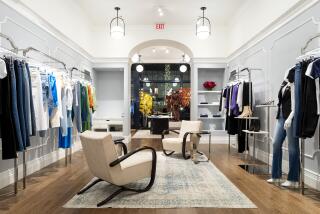As Monah Li Closes Up Shop, L.A. Fashion Is Down One Designer
Los Angeles fashion designer Monah Li, best known for her feminine, deconstructed clothes made from old slips and cashmere cardigans, has shuttered her business, a spokesperson confirmed Thursday. But it’s not because she’s giving up fashion. Li, who opened her company in 1996, has been hired as a designer for the San Francisco-based contemporary women’s apparel chain Bebe.
Li, who grew up in Austria, made her first dress at age 7. She studied painting and fashion design at the Academy of Art in Vienna.
After gaining recognition as a singer and performer in Austria and Germany in the early 1980s, she moved to Los Angeles in 1988. Here, she launched her first collection of playful rayon print baby doll dresses.
Her offbeat look has been a favorite with celebs such as Christina Ricci, Salma Hayek, Nicole Kidman and Ione Skye. Li’s store and headquarters in Silverlake have been closed since early December.
*
Despite the mixed success and sometimes failure of magazines aimed at Asian Americans, publisher Angelo Ragaza is throwing his hat in the ring.
With publications such as A. magazine and online sites such as Junmagazine.com and Jademagazine.com already competing to lure prized retail, beauty and fashion advertisers, as well as Asian American women readers, a new competitor is launching in September.
With Element, a bimonthly Asian American women’s magazine, Ragaza hopes to emulate the quality of successful fashion magazines Vogue and Allure, while following in the footsteps of ethnic niche publications such as Latina and Essence in capturing a young and educated readership.
Founder Ragaza, 33, a Filipino American and graduate of Columbia University, is venturing out on his own after his involvement with A. magazine, where he was features editor for five years, managing editor for two years and editor in chief for two years.
He said A. was a terrific training ground for his venture, but he wants to create a magazine that catches the full attention of the fashion/beauty advertising arena.
Ragaza cites a study by the Selig Center for Economic Growth at the University of Georgia for his inspiration. The study projected that the Asian market in the United States will have close to $254 billion in buying power in 2001.
“Advertisers already perceive Asians to be consumers of the high-end market,” Ragaza said. “[But] Fashion and beauty [advertisers] are hard to break because you need to have a certain amount of traction, a large circulation,” which is difficult for magazines with a very specific niche audience.
He also wants the magazine to have high-quality writing. “We want to have writing of real journalistic excellence and literary quality,” Ragaza said. “I don’t want Element to be superficial.”






